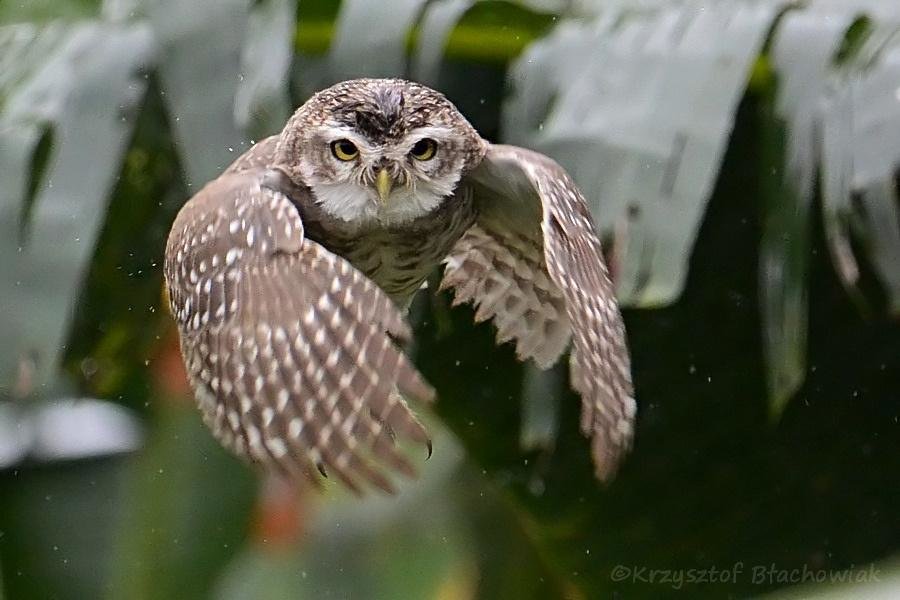Spotted owls facing their nemesis

Spotted owl upper parts are brown, colder and darker with white spots; dusky facial disc with broad white patch over and below the eyes, forming broad white spectacles, crown and nape finely spotted white. When perched, a broad white collar around the front of the neck is distinctive; under-parts strongly barred or spotted. Juveniles are gingery, with diffuse barring below. As mentioned before, spotted owls are crepuscular but frequently seen in daytime.
Wise owls
For centuries, owls have had a reputation for being wise birds. This came about because in Greek mythology, the spotted owlet was the sacred bird of the goddess of wisdom, Athena. She gave her name to Greece’s capital city, Athens. The best-known coin of the ancient Greek world was issued in Athens and featured an owl.
Good hunters
Owls are the supreme night hunters, their bodies well adapted for hunting in the dark. But spotted owls are diurnal too. For one thing, they fly silently. The flight feathers on their wings are covered with a fine down to muffle the sound of air passing through them. The owl’s eyes are particularly adapted for night vision. They contain many more rods than the eyes of other species. Rods are the structures that make eyes sensitive to light. The owl’s hearing is superb, too. The rings of fine feathers owls have around each eye help channel sounds into the ears. The ears themselves are surrounded by flaps of skin that can be moved to pinpoint exactly the sources of sounds. A few other raptors such as spotted owls also hunt after sundown. They eat bats, swallows and insects while in flight. They see well in low light levels, although not in complete darkness, and many can pinpoint prey accurately by sound alone. Their ears are slightly asymmetrical in size, shape, or position. As an owl twists and bobs its head it is using this adaptation to get a “fix” on its prey. Owls often attract the attention of smaller birds (and also sometimes jays) if discovered by day, and mixed parties “mob” the roosting owl with loud calls, sometimes diving at its head.
Spotted little owl in Iran
Spotted little owl also lives in Iran. Southern parts of Iran are their main habitat. There is no population survey in our country and even their distribution is in doubt. They are very noisy in breeding season; often short, loud series of chattering, harsh shrieks including rapid and sudden outbursts, rising and falling in tempo and pitch: kuerk-kuerk-kuerk… reminiscent of domestic cats fighting. Spotted little owl lives in gardens, villages, cultivated areas, semi-deserts and earth cliffs. They nest in hole in tree or wall.
Spotted owls facing extinction
In the early 1990s the spotted owl, which many people had never heard of, was listed as threatened under the U.S. Endangered Species Act. Experts claimed that the spotted owl nested and lived only in old- growth forests (forests that have never been cut and thus consist mainly of large, ancient trees) of the Pacific Northwest. The experts said that widespread clear-cutting of these forests- the usual logging practice in the Pacific Northwest at that time- was going to cause extinction of these owls.
The federal government funded a study involving 600 scientists, who produced a Northwest Forest Plan that required conservation of existing old-growth forest. This plan caused one of the greatest economic changes of any American conservation policy, putting a stop to logging on 2.4 million acres in the state of Washington alone, and ending an estimated 30,000 jobs in the state. Towns like Forks, Washington, on the Olympic Peninsula, which had been a center for the timber industry, found themselves with many people out of work and forced to seek other kinds of jobs.
As you can imagine, the whole issue caused fierce arguments. Opponents claimed that the owl could live just as well in second- growth forest (forests that have grown back after logging, thus having young and relatively small trees and lacking many other features of an old- growth forest). They said the owl and the loggers could continue together, and that in any case the owl was not worth the cost. They claimed that the real goal of the so-called supporters of the spotted owl was to stop the logging and preserve old-growth forests, and they cried “Fowl”!
Ironically, although much old-growth forest has been conserved for the owl, today this species is suffering from other threats. The barred owl, a competitor, is moving into the spotted owl’s habitat; in fact the two species cannot coexist. Not only is the barred owl driving out the spotted owl, but in addition a new disease called “sudden oak disease” is killing many oaks and may wipe out the owl’s preferred tree, the tanoak. As well, the introduced West Nile virus is attacking the spotted owl. And the story of spotted owl conservation continues till now. There are many challenges and questions, all without answer: why clear cutting of forests considered so bad? Was old-growth forest actually necessary for the owl? Do we really need all that forestland, and who cares about some little owls that most of us will never see? Similar questions exist in our country too.
What is the answer?
A big question is: “Can we have our forests and wildlife and use them too?” The answer is: “Yeah, we can if we understand how they work.” This means that we have to apply a scientific approach to forestry and wildlife management, and recognize that forests and the wildlife that live in them are always changing. We can but we may achieve this best by seeking the two goals in different places at the same time. We can but only if we seek long-term historical records. This means that long-term scientific monitoring is necessary.

Leave a Comment